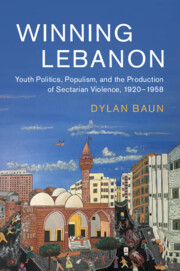Book contents
- Winning Lebanon
- Cambridge Middle East Studies
- Winning Lebanon
- Copyright page
- Dedication
- Epigraph
- Contents
- Figures, Maps, and Tables
- Acknowledgments
- A Note on Conventions
- Introduction
- 1 The Future of Young Men
- 2 Producing Space
- 3 Broadening the Base
- 4 In Defense of Lebanon
- 5 Fighting the Punks
- Epilogue
- Bibliography
- Index
- Books in the Series
4 - In Defense of Lebanon
The Nonsectarian Causes of the 1958 War
Published online by Cambridge University Press: 16 October 2020
- Winning Lebanon
- Cambridge Middle East Studies
- Winning Lebanon
- Copyright page
- Dedication
- Epigraph
- Contents
- Figures, Maps, and Tables
- Acknowledgments
- A Note on Conventions
- Introduction
- 1 The Future of Young Men
- 2 Producing Space
- 3 Broadening the Base
- 4 In Defense of Lebanon
- 5 Fighting the Punks
- Epilogue
- Bibliography
- Index
- Books in the Series
Summary
Chapter 4 examines what transformed popular organizations from allies to enemies in the late 1950s. On one side of the conflict were those groups against the government and Lebanese President Camille Chamoun. They included the Progressive Socialist Party, Najjadeh, Lebanese Communist Party, and the Arab Nationalist Youth. In speeches, petitions, and articles, these groups claimed that Chamoun’s recent actions in domestic and foreign policy were authoritarian, represented a threat to sovereign Lebanon, and were grounds for armed revolution. On the other side were the Kataʾib and Syrian Social Nationalist Party. They made the point that foreign interference from Syria and Egypt, and its leftist sponsors in Lebanon (most notably, the Progressive Socialist Party), challenged Lebanon’s sovereignty, the constitution, and their group. Given that defending Lebanon and its sovereignty was not, at least in the eyes of multiple popular organizations, sectarian, Chapter 4 represents a need to rethink sectarianism among sociopolitical actors in and beyond 1958. Indeed, whether groups had clear sect majorities (the Kataʾib and Najjadeh) or not (the Syrian Social Nationalist Party and Lebanese Communist Party), I argue that their perspectives before the conflict were quite complex, linked to multiple factors, and cannot be reduced to sectarianism alone.
- Type
- Chapter
- Information
- Winning LebanonYouth Politics, Populism, and the Production of Sectarian Violence, 1920–1958, pp. 128 - 154Publisher: Cambridge University PressPrint publication year: 2020

